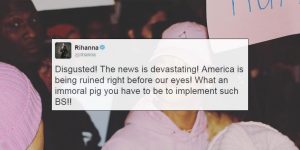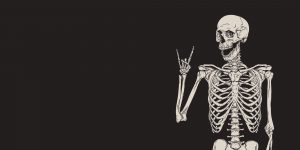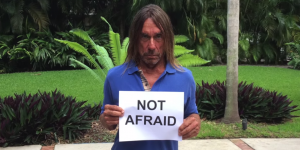How Springsteen and Prince took over pop music 30 years ago
by Ryan McNutt
June 26, 2014
Born in the U.S.A. and Purple Rain were released a mere three weeks apart in 1984 — and they weren’t as different as you might think.
Walter Yetnikoff, the infamously drug-fuelled CBS Records president, prided himself on being able to recognize hits. And in early 1984, when he heard Bruce Springsteen’s “Dancing in the Dark,” he felt he had a number one smash on his hands.
“I don’t know if I wet my pants, but I might have,” Yetnikoff recalls in Peter Ames Carlin’s biography, Bruce.
And no wonder: on an album full of potential (and eventual) hits, “Dancing in the Dark” cut through like a knife. With a dance beat and a synthesizer riff, it was the first song Springsteen had recorded that actually sounded explicitly of the moment, but still maintained that sense of fight-or-flight desperation and impassioned delivery that had made him one of the biggest rock stars on the planet. Now, he was poised to become a pop star as well.
Yetnikoff was right about “Dancing’s” potential, but wrong about its number one status: it stalled at number two. The song that held it back was from a purple-clad virtuoso musician who, like Springsteen, had his sights set on being the biggest pop star on the planet — and he had the album, and film, poised to get him there.
His name was Prince.
Released a scant three weeks apart in June 1984, Springsteen’s Born in the U.S.A. and Prince’s Purple Rain dominated their calendar year in a manner unlike few albums before or since. Born became the number one record in America on July 7 and, from that point on, one of the two albums sat atop Billboard’s album chart for an astonishing 25 weeks — for 18 of them, Purple Rain at the top and Born in the U.S.A. right behind, the longest static one-two reign in the chart’s history. Fuelling those album sales was a series of massive singles: Born in the U.S.A. with seven top 10 hits, Purple Rain with four.
In a 2014 context, this sort of pop dominance seems bewildering. These days, a hot new release seemingly bounds up the album charts each week, only to plummet back down once the diehard fans have picked up the record. There are exceptions — Adele’s 21, the top selling album of both 2011 and 2012, and the Frozen soundtrack — but those albums aren’t singles behemoths in the style of the Class of 1984, and albums that do produce multiple hits (Katy Perry’s Teenage Dream, for example) aren’t sales dynamos because people just buy or stream the singles digitally. Last year, 44 different albums went to number one in the U.S. In 1984, in contrast, Purple Rain and Born in the U.S.A. were two of only five albums TOTAL that did so. (The others were Thriller — a holdover from 1983 — the Footloose soundtrack, and Huey Lewis and the News’ Sports.)
What was happening in 1984? On the one hand, you had a collusion of media-related factors that made blockbuster albums more likely: the decline of the retail single, the continued influence of commercial radio, and the rise of MTV, offering a new, hugely influential platform to push big stars and big singles. But you also had artists like Springsteen and Prince making an explicit play for pop dominance, blurring genres, styles, and sensibilities, and becoming icons in the process.
Both Prince and Springsteen were arguably better at other points in their careers, but they were never bigger than they were in 1984 — and they weren’t as different as you might think.
That claim, on the surface, may seem as silly in 2014 as it would have 30 years ago. Today, Springsteen’s status as blue-collar icon remains intact, whereas Prince is a renowned touring artist but, creatively, hasn’t been culturally relevant in a couple decades. Politicians tried to co-opt Born in the U.S.A., whereas Purple Rain raised their ire. Springsteen is straight white masculinity personified, whereas Prince in his prime represented mysterious, deeply sexualized black androgyny.
Yet both Born in the U.S.A. and Purple Rain were, essentially, trying to accomplish the same feat in 1984: turn an already-popular artist into a superstar by enveloping different sounds and styles to reach new audiences, with pop radio (and, soon, MTV) as the platform of choice. Both Springsteen and Prince were attempting to follow-up successful records featuring the artists’ first top 10 singles. Each had probably gotten as far as they could go, commercially, with their existing template. To continue to reach more and more listeners, they’d have to expand their sound — or, not to put too fine a point on it, they’d have to start sounding more like each other.
Consider, for example, one story about the genesis behind Purple Rain’s title track. As recounted by Revolution keyboardist Dr. Fink, Prince was playing similar markets as Bob Seger, often touring the same cities one after the other. Prince was curious as to why Seger was so popular, given how different Seger’s style was from his, and Dr. Fink and Prince talked about the power of crossover hits: at the time, Seger had largely left behind his early R&B sound to target the adult pop charts in Springsteen-ian fashion with great success. “Purple Rain,” a rock power ballad in its purest form, seems to owe a lot to that thinking.
Of course, much of Purple Rain still sounds like a Prince album, just like how if you change a few production tweaks, most of Born in the U.S.A. isn’t all that different from The River. But those tweaks are the difference between a cult hit and a blockbuster: the disco rhythms at the heart of “Cover Me,” the extra reverb on Max Weinberg’s drumming throughout the record and, of course, the switch from rock organ to pop synthesizers that helped turn tracks like “Dancing in the Dark,” “I’m on Fire,” and the title track into hits. It still sounded like Springsteen, but it also sounded like pop radio in 1984 — just like how Purple Rain would be familiar to Prince fans but would sit perfectly alongside Springsteen on the radio dial.
There are other similarities between the albums. Both their first and biggest singles were last-minute additions: “When Doves Cry,” because director Albert Magnoli wanted one more song for a particular sequence in Purple Rain’s accompanying motion picture; “Dancing in the Dark” because producer Jon Landau wanted one more song that could be the hit. (“Dancing” could be read, lyrically, as a metaphor for Springsteen’s creative frustration at the request — a very inspired one, at that.) And both records were band albums, their successful sound owing as much to the live-off-the-floor recording talents of their players as they do studio craftsmenship.
But the albums’ largest commonality might be their place in the visual culture of 1984. Springsteen had only made one music video prior to Born in the U.S.A. (“Atlantic City,” which he didn’t even appear in.) But he finally showed some willingness to do what it took to get played on MTV: a big budget director (Carrie and Scarface director Brian de Palma), dance moves, and a pre-fame Courtney Cox. “Dancing in the Dark”’s impact was so massive that, to this day, Springsteen still pulls girls from the crowd to dance with him when he performs the song. Then there’s Purple Rain the film: an endearingly gawky, somewhat embarrassing semi-autobiographical film that becomes something transcendent whenever Prince and the Revolution are on stage. It’s, quite simply, some of the most remarkable performance footage ever put to film. “Dancing in the Dark” and Purple Rain may show their age but, in their time, they made Springsteen and Prince look like the superstars they were about to become.
This is not to say, however, that Prince and Springsteen were on the exact same page 30 years ago.
Politics was a great divide. Ronald Regan infamously attempted to co-opt Springsteen and Born in the U.S.A., suggesting they reflected similar values to his presidential campaign. This attempt is typically laughed off as embarrassing today, given Springsteen’s open support of Democrats and “Born in the U.S.A.’s” status as a protest song. But Springsteen wasn’t as politically vocal in 1984 as he is now and there’s a strong small-r republican streak running through his songwriting, repeatedly making the case for the value of family and community even as he’s chronicling their shortcomings. Throw in some traditional (in some cases regressive) gender norms and you can see Springsteen’s conservative appeal.
Prince never once had to be concerned about being championed by politicians; in fact, he was literally public enemy #1. Purple Rain’s “Darling Nikki,” an ode to a “sex fiend” who Prince first meets “masturbating to a magazine,” held the top spot on the Parents Music Resource Center’s (PMRC) “Filthy Fifteen” list of songs in 1985. The organization, established by the wives of several prominent politicians and whose efforts led to the creation of “parental advisory” labeling, came about when Al Gore’s wife Tipper was outraged upon discovering “Darling Nikki” on her daughter’s copy of Purple Rain.
Yet these stereotypes — Prince as sexual deviant, Springsteen as virtuous working-class hero — start to show holes upon closer inspection. “Darling Nikki’s” backwards-sung outro, when the vinyl record is played in reverse, says, “Hello, how are you? I’m fine ‘cause I know the Lord is coming. Coming, coming soon.” (And isn’t “Purple Rain” borderline gospel anyway?) Springsteen sings about sex and desire less explicitly than Prince, but carnal lust clearly fuels songs like “I’m on Fire,” and album b-side “Pink Cadillac,” as obvious a sexual metaphor as Prince’s “Little Red Corvette.” Then there’s “Working on the Highway,” based on a song originally written for Nebraska called “Child Bride.” The song’s final incarnation talks around its premise somewhat, but is still quite clearly about a man doing time for running away with a teenage lover below the age of consent. Even Springsteen’s heterosexual masculinity warrants scrutiny: the ass-shot album cover, the lack of gender pronouns in a song like “Bobby Jean”… if you were looking for queer readings of Born in the U.S.A., you’d have plenty to work with.
But here’s one thing that truly separates Purple Rain from Born in the U.S.A. No one would blink an eye today if you considered Purple Rain to be Prince’s best album (though many, including me at times, would make the case for 1987’s Sign ‘o’ the Times). But Born in the U.S.A. earns no such favour from Springsteen fans; you’d be hard pressed to find one who even ranks it among his three best albums. This has led to the album being seemingly both overrated and underrated at the same time: overrated because its popularity in the mid-80s certainly eclipses its quality, but underrated because it’s a far better album than it’s given credit for. It’s been forced to wear the rockist sin of commercial ambition, not to mention some of the excessive “Brucemaina” it caused, but it’s arguably a more successful set of songs than the equally-scattered River is, and even its more dated sounds still hit with impressive power. Purple Rain, however, doesn’t really sound dated at all: while it wouldn’t be a blockbuster in the same fashion if it were released today, I have no doubt Purple Rain could be a critically acclaimed hit record all the same. It still sounds that good.
Yet, for the degree they dominated 1984, there’s not much evidence of Springsteen and Prince crossing paths, professionally or personally, during that time. They were both nominated for the Album of the Year Grammy, but lost to Lionel Richie’s Can’t Slow Down. (Shockingly, the Grammys used to be considerably more embarrassing than they are today). In various interviews, the two complimented one another: Springsteen telling Rolling Stone in 1985 that Prince was “one of the best live performers I’ve ever seen in my whole life,” and Prince saying in 1990 that while he wasn’t really into Springsteen’s music, he had a great respect for his talent and enjoyed his shows. But despite the kind words, the two very private stars never spent much time in the spotlight together.
The one exception was on February 23, 1985, at Prince’s show at the Los Angeles Inglewood Forum. The Purple One had two special guests with him that night. The first was Madonna, whose Like A Virgin had just been released a couple months earlier and who was beginning her own ascent into pop superstardom. The other was Springsteen. The two joined Prince on “Purple Rain” and, most appropriately, “Baby I’m a Star.” There’s a bootleg circulating of the show, though I’ve never managed to track it down myself. But there is this photo, offering one final piece of evidence to my case that there wasn’t all that much difference between Springsteen and Prince in the mid-1980s.
They had the same amazing/awful haircut.
Tags: Music, Featured, Bruce Springsteen, Prince






